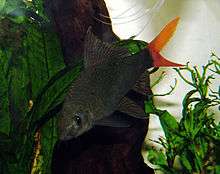Red-tailed black shark
| Red-tailed black shark | |
|---|---|
 | |
| A red-tailed black shark | |
| Scientific classification | |
| Kingdom: | Animalia |
| Phylum: | Chordata |
| Class: | Actinopterygii |
| Order: | Cypriniformes |
| Family: | Cyprinidae |
| Genus: | Epalzeorhynchos |
| Species: | E. bicolor |
| Binomial name | |
| Epalzeorhynchos bicolor (H. M. Smith, 1931) | |
| Synonyms | |
|
Labeo bicolor | |
The red-tailed black shark (Epalzeorhynchos bicolor; syn. Labeo bicolor), also known as the redtail shark and redtail sharkminnow, is a species of freshwater fish in the carp family, Cyprinidae. It is endemic to Thailand and currently critically endangered,[1] but common in aquaria, where it is prized for its deep black body and vivid red or orange tail. The red-tailed black sharks seen in the aquarium trade today are all captive bred.[1]
It is not closely related to sharks.
Distribution
The species is endemic to Thailand, and was described by Hugh M. Smith in 1931 as being 'not uncommon' in Bueng Boraphet and the streams which lead from it, and as being found in the Chao Phraya River as far south as Bangkok.[2] A 1934 expedition reported catching a specimen in the Silom canal.[3] As of 2011 it is only known at a single location in the Chao Phraya basin, and has Critically Endangered status on the IUCN Red List.[1] From 1996 until 2011 it was believed to be Extinct in the Wild. There is no evidence that collection for the aquarium trade is responsible for the species' decline, and it is more likely that construction of dams and draining of swamps that took place during the 1970s was to blame.[1]
Size and age
Red-tailed black sharks can reach a length of 16 cm (6 in).[4] They can live up to 8 years, although in some rare cases they have lived to be over 18 years old.
In the aquarium
In the aquarium trade, tail colors can vary, with bright red and orange being the most common. If the shark is stressed or unhealthy, the red color will drain from its tail. Albino forms may also be encountered.
pH and water temperature
In home aquaria, redtail sharks prefer a pH between 6.8 and 7.5, a temperature between 22 °C and 26 °C (72 °F and 79 °F) and water hardness between 5 and 15 dH.
Behavior
Typically they are aggressive chasers, but will rarely bite or harm other fish. Individual personalities vary greatly—some are calm, while others are rather aggressive towards tank mates. They are bottom dwellers and like lots of dark hiding places. They get along with other semi-aggressive fish, but they do not like other sharks.
When two red tails cohabitate, they have been known to become extremely territorial with one another. One shark will become dominant and will continually chase and harass the submissive shark, preventing it from feeding and resting. This will often result in the death of the submissive redtail shark. Larger groups of five or more, surprisingly, tend to get along much better than two or three, as they will establish a stable hierarchy; such a group will require a very large heavily planted aquarium, however.
Redtail sharks are considered compatible in some community tanks, although they may chase docile or peaceful fish that present a large target (such as the Metynnis argenteus, or "silver dollar" fish). This may be physically harmless, but could cause a great deal of stress for the pursued fish, sometimes resulting in death due to stress. Redtails do not typically bite or injure other fish, but they will chase them and try to corner them. They will mostly chase fish away from their territory and then retreat; therefore, it is important to ensure the aquarium is large enough to allow the redtail some space to call its territory. Aquariums should be at least 170 litres (45 gallons) or larger for a comfortable community. Redtails are bottom dwellers, so it is strongly suggested that one does not introduce them into an aquarium with another bottom dweller, as they will constantly pester and harass it. They also should not be introduced to communities containing other shark-like fish.[5][6] Despite this, it is often reported that they do not generally harass loaches, such as Chromobotia macracanthus, and may even exhibit schooling behavior with them.
Footnotes
- 1 2 3 4 5 Vidthayanon, C. (2013). "Epalzeorhynchos bicolor". IUCN Red List of Threatened Species. Version 2014.1. International Union for Conservation of Nature.
- ↑ Smith, Hugh W. (1931). "Descriptions of new genera and species of Siamese fishes". Proceedings of the United States National Museum. 79: 1–48. doi:10.5479/si.00963801.79-2873.1.
- ↑ Fowler, Henry W. (1934). "Zoological Results of the Third De Schauensee Siamese Expedition, Part V: Additional Fishes". Proceedings of the Academy of Natural Sciences of Philadelphia. 86: 335–352. JSTOR 4064154.
- ↑ http://www.tropical-fish-success.com/red-tail-shark.html
- ↑ Mixing Red Tailed Black Shark
- ↑ The Aquarium Wiki - Red Tailed Shark
References
- "Epalzeorhynchos bicolor". Integrated Taxonomic Information System. Retrieved 24 January 2006.
External links
- Care information for the Red-tailed black shark at the Aquarium Wiki
- Red Tails in the Aquarium
